To introduce OPC and plug-and-play technology, focus on the development of OPC practical application standards, technology, features and scope of application and interface applications.
1. Introduction - Background of OPC Development
Automation technicians have a beautiful dream, whether it is possible to connect automation control software and hardware. Instead of thinking about driver and interface issues, it's very simple Plug&Play{Plug and Play}. Using OPC (OLE for Process Control) can help achieve this dream. Of course users are very interested in this. And first won the support of automation software manufacturers - the first batch of OPC products have been placed on the market before the date determined by the standardization committee. In the previous communication technology specifications in the field of automation, few of them have caused such a strong sensation as the new OPC technology standards. OPC is an acronym for OLE (OLE for Process Control) for process control. It has been gradually developed by today's manufacturers of automation components into a de facto new technical standard, and the so-called OLE meaning is the object. Link and embed for process control.
Today, the importance of software in the field of automation is increasing. Regardless of whether the project involves operations, visualization, data archiving or control, the trend toward pure, PC-based software solutions is unstoppable. Time has proven that these software solutions are no longer a single block of development, but a dedicated single software component. The ability to use reusable modules and the flexibility of the modules to form the entire system seems to be nothing to replace, the only exception being the incompatibility of the communication interface. The time and money used to adapt the communication interface is a must, and the purpose is to combine these software modules together. This has led to the development of hundreds of communication interface software programs, such as interface programs for process control or visualization systems to communicate with peripheral devices. However, at the same time, it has also significantly increased costs. OPC (OLE for Process Control) provides a remedy for this situation: OPC combines software components such as software connectors that communicate with each other without special adaptations. Therefore, plug and play becomes a reality in automation. So you can answer the question of why you need OPC?
2. Why do you need OPC?
Specifically, it can be explained from the following two points:
First, for early computer systems, in order to realize data exchange and communication between computers composed of different hardware and software, it takes a lot of time to develop a separate communication program. But it is precisely because of the industry standard of data exchange and communication that it is possible to realize that different computers are connected to each other as a huge network like the Internet. Therefore, when developing an enterprise information system, if an industry-standard database and a client-server interface are used, effective efforts can be made to invest more in the development of the application itself.
Second, the same problems exist in industrial manufacturing systems. That is to say, the machines provided by different suppliers can be connected to each other without special software development. For example, when implementing a multi-layer production control information system like FIG. 1, an effective data exchange is established and popularized from the field device layer of the processing device data, to the process control system layer performing the process processing, and even to the uppermost production management layer. Industry standards will be a priority. In this case, it is the original purpose of OPC to realize the standardization of data exchange in process control of industrial manufacturing systems by using OLE/COM technology in Microsoft Windows Windows.

3. What is OPC? OPC defines an open interface on which PC-based software components can exchange data. It is based on Windows OLE - object linking and embedding, COM - component object model and DCOM - distributed COM technology. Thus, OPC provides an ideal method for connecting industrial applications and office programs to typical field devices in the automation layer. The introduction of the standard interface of Windows programs has enabled hardware manufacturers to reduce the number of interface programs developed for their components to one. Only one interface program for OPC servers needs to be developed. Similarly, software manufacturers only need to develop a unique communication interface. Program - OPC client interface. This is not only beneficial to the manufacturer, but also to the end customer. In this case, the above-mentioned OPC based on COM technology should be specifically divided.
3.1 OPC based on COM technology
In order to provide connectivity between business applications and specific-purpose software packages, Microsoft has developed a so-called component (component) object model technology. COM is an effective way to exchange data between software components. It is a binary and network standard. It is also DCOM, ActiveX (Active X is an update and upgrade to the widely used OLE control technology. It relies on COM technology, is the name change and refactoring of OLE control technology) and the core of OLE technology.
The COM technology has the following features:
* The so-called COM is not a computer language, it is independent of the operating machine, the operating system of the machine (as long as it supports COM) and the software development language. It is a binary and network standard that can communicate with each other between two software components. .
* The COM server is a executable program that provides COM services according to the requirements of COM clients and can be published as executable files on Win32 servers.
* COM client and COM server can be developed in completely different languages. This allows programs developed in different languages ​​such as Visual Basic, which use C++, Visual Basic, and Excel as applications for macros to be connected to each other.
* COM components can be distributed to users in binary form.
* COM technology can provide maximum compatibility between different versions of COM servers and COM clients compared to the very difficult problem of version management of past DLLs (Dynamic Chain Database).
* As a COM technology extended distributed COM technology, COM components can be distributed on different computers and connected to each other and exchange data with each other. So for the COM client, it is also like connecting the COM server on the local computer to connect to the COM server on the remote computer. Of course, the communication speed is not the same, but it is important that the server program can be modified without having to modify the server program. The free connection constitutes the interconnection of components achieved by COM and DCOM (distributed COM) as shown in FIG. 2.
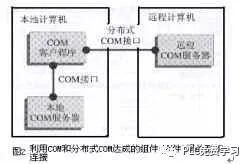
The advent of COM technology provides a technical basis for simply implementing data exchange between control devices and control management systems. However, if an industrial standardized COM interface is not provided, the interconnection between COM components developed by various control equipment manufacturers is still impossible. The provision of such industry standards is the purpose of OPC. In summary, OPC is a special COM interface defined as an industry standard.
3.2 Comparison of OPC and DDE
Prior to the advent of OPC technology, DDE (Dynamic Data Exchange) technology had made a significant contribution to process control. However, DDE is a technology based on Windows information transfer, so DDE technology has the following problems: * Data transfer speed is slow * No security management mechanism * Development difficulties * Lack of flexibility * Reliability is also unsatisfactory, so based on The advanced COM technology OPC technology will gradually replace the position of DDE that is now widely used in process control. With the introduction of OPC technology, compared with the past DDE technology, it shows its superiority in the following aspects: * High-speed data transmission performance * Security management mechanism based on distributed COM * Reduced development cost * Realized with height Flexible function system* for systems with high reliability
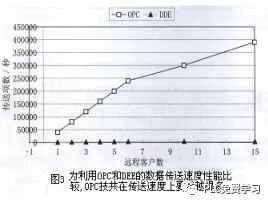
FIG. 3 is an example of experimental results of data transfer performance using OPC and DDE, respectively. From here, we can also see the superiority of OPC technology in transmission speed.
4. How do users get benefits from OPC?
In the past, only limited interface programs were generally compatible with dedicated automation components. It is well known that it is not possible to develop an interface program for all proprietary interfaces. The obvious innovation today is that the user can combine any visualization or control system with any selected hardware (ie PC board) via OPC, as shown in Figure 4. As can be seen from Figure 4, the OPC-standard software bus enables integration of a variety of existing bus systems, such as PROFIBUS networks, CANopen (open control local area) networks, and Device Net (device networks). The standardization relationship between OPC and fieldbus can also be deeply reflected from Figure 4: OPC provides important additional performance beyond fieldbus, and the main goal of fieldbus standardization is fast and reliable data transmission. OPC enables standard communication to the extent that any OPC server and application software can run online without any problems.
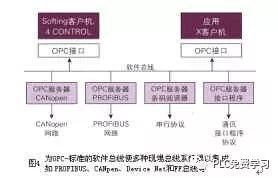
In Figure 4, PROFIBUS is an internationally recognized open fieldbus standard and is a component of the international standard IEC61158, Type III. The advantages of interface programs and OPC server quality further extend this advantage, and manufacturers can focus their efforts on developing a unique OPC server, because without having to deal with numerous interface programs, they can focus on adding additional features. Sex and work to improve operator friendliness. Moreover, conformance testing conducted by a dedicated OPC Foundation promotes the quality of OPC products. In the past, the use of proprietary interface programs was often limited to a single application. An application can now access the OPC server via an OPC interface with several clients. Thus, the functionality and internal data of the OPC server can be accessed more flexibly. This multi-client capability not only brings benefits to local PCs, but can also be used on distributed networks via DCOM (Distributed Component Object Model). Thus, for example, a visualization system running on an office computer can be linked to an OPC server located on the factory floor without having to purchase additional interface program software. The flexibility and high level of maneuverability of OPC gives manufacturers and users the following benefits from OPC:
* Device developers; can make the simplification of device driver development possible. * Application software developers: Universal development tools are available. There is no need to develop special interfaces, making the development of device interfaces easier. * User: A variety of commercial software packages are available, which greatly reduces the cost of the system. At the same time, it is easier to implement an industrial control system composed of a mixture of equipment supplied by different suppliers. With the promotion and popularization of control components based on the OPC standard, not only the addition of control systems and the replacement of components are made simpler, but also the access of process data is made easier. For example, the process control program can be directly connected to a data analysis software package or a spreadsheet application to achieve a high degree of informationization of the plant control system. To this end, you can break down OPC in detail how to solve your problem?
5. How does OPC solve your problem?
It should be said that before the birth of OPC, there was no uniform standard for the interface between the hardware driver and the application connected to it. For example, in the field of FA-factory automation, connecting control devices such as PLCs and SCADA/HMI software requires different FA network systems. According to a survey result, in the cost of control system software development, the application design of various machines accounts for 70% of the cost, while the connection interface between development machines and equipment accounts for 30%.
In addition, in the field of PA-process automation, when it is desired to transfer all the process data in the distributed control system (DCS-Distributed Control System) to the production management system, it is necessary to develop a specific interface according to each model of each supplier, for example, Design applications using DDE (Dynamic Data Exchange) servers connected by C language DLLs (Dynamic Link Database) or using FTP (File Transfer Protocol) text. When the system consists of four kinds of control devices and monitoring, trend graphs, and reports of three kinds of applications, it takes a lot of time to develop monitoring, trend graphs, and tables for the corresponding devices A, B, C, and D. A total of 12 drives are used for the interface software of the application. At the same time, the stability and reliability of the maintenance environment are more difficult due to the coexistence of various drivers in the system. OPC is proposed for the purpose of standardizing software interfaces between devices and applications of different vendors and simplifying data exchange between them. As a result, it is possible to provide the user with a process control software component product that can be freely combined and used without relying on a specific development language and development environment. The OPC system is composed of an OPC server that provides data collection services according to the requirements of the application (client program), an OPC interface necessary for the OPC server, and an OPC application that accepts the service. The OPC server is developed according to the hardware of each vendor, so that it can absorb the differences between hardware and system of each vendor, thus implementing a system configuration that does not depend on hardware. At the same time, using a data type called Variant, you can provide data format according to the requirements of the application without depending on the inherent data types in the hardware.
Standardizing the interface with OPC can constitute a system as shown in FIG.
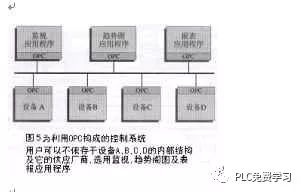
As can be seen from FIG. 5, the user can select the monitoring, trend graph, and reporting application without depending on the internal structure of the devices A, B, C, and D and its suppliers.
6. Where is OPC suitable for?
OPC is a software interface standard between a data source (OPC server) and a user of data (OPC application). The data source can be a control device such as a PLC, a DCS, or a barcode reader. Depending on the composition of the control system, the OPC server as the data source can be a local OPC server running on the same computer as the OPC application, or a remote OPC server running on another computer. As shown in Figure 6.
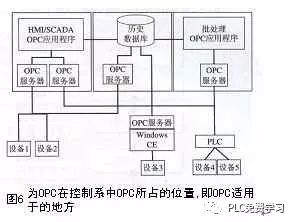
As can be seen in Figure 6, the location of the OPC in the controlled system. The OPC interface can be applied to the original data of the lowermost control device through the network to the user (OPC application) HMI (hardware supervision interface) / SCADA (supervised control and data acquisition), batch processing and other automation programs. Applications such as the upper-level historical database can also be applied to direct connections between applications and physical devices. Therefore, the OPC interface is an interface standard with high thickness flexibility for many systems. The scope of application of its OPC can be seen in Figure 7.
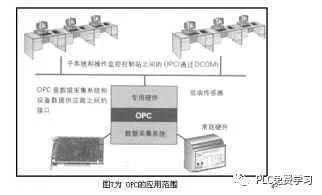
Since the OPC interface is mentioned, it is necessary to explain the definition of the OPC interface.
6.1 OPC interface definition description
The OPC interface defines certain component types and determines what properties these components must have. Such a "service provider" is called an OPC server. The unique OPC server enables the connection of existing communication systems. The service user of the OPC server is called an OPC client. The OPC client can be an operating and monitoring system, an archiving system, and many other process data users. This service will be reflected in object-oriented properties and methods. Each OPC server provides a section of this property and method. Therefore, collaboration between component manufacturers of different manufacturers will not be a problem - plug-and-play technology for automated technology software.
6.2 The application of the OPC interface?
Under what circumstances, the user needs to use the OPC interface, that is, the component manufacturer (communication system, measuring instrument, etc.) that provides the process data, and use the component together with the OPC server. The OPC server can be connected to a data source. The communication transformation component with the data source is the sole responsibility of the component manufacturer. Users of the OPC server do not have to ask the manufacturer for details.
The OPC interface has nothing to do with the specific application, even if the traditional office application can be connected to the automation system; the user will decide, without regard to the driver or interface, you can choose the automation component with OPC installed, which is both laborious and time-consuming to match the driver. The work will be gone forever, which will greatly reduce the cost of the project.
7. How powerful is OPC?
In order to qualitatively judge the performance of the OPC, the selected instrument was tested in Softing (soft) and used two commercial PCs. Configured with a Pentium 90 processor, 48 or 64 megabytes of memory, deliberately using a low-performance configuration computer to eliminate good measurement results is attributed to high-performance computers, the operating system on these two computers is Windows NT4.0.
For local testing, a small OPC client test application and a PROFIBUS DP OPC server from Softing are installed on a PC. For testing of distributed OPC applications containing DCOM, the OPC test client is in the second Boot on a remote PC. Between the local and the two-in-one computer, the change value of 5000 process variables (a very practical visualization system) can be transferred between the OPC server and the OPC client within 1 second. For a case with only 500 process variables, only 100 milliseconds is required. OPC is therefore well-suited for applications that acquire large amounts of dynamic process variables at very short update rates.
This is why in addition to those products that are used in process visualization and data acquisition. Programs such as S0ft-PLC 4CONTROL for time critical control will be based entirely on OPC reasons. In this configuration, the remote PC is connected to the first PC via the company's internal network. The test is selected to be a daily report delivered by event-driven data. The OPC server continuously generates values ​​that are passed to the OPC client. The test group repeatedly tests the time from the first time the CPU (Network Terminal) interface program's cache reads a limited number of data values ​​until the full value is received and confirmed by the OPC client. The result is that only pure server-to-client transfer times need to be considered, regardless of the time it takes to collect values ​​from the automation device.
Because OPC discards the test client after it receives the data, all specific application processes such as data archiving or visualization are included in the test. The values ​​measured continuously from different times are averaged. The number of values ​​transmitted to the OPC client ranges from 1 to 5000 to investigate the dependence on the transfer time.
8, integrated OPC server
The "Zero Engineering" visualization feature included in the 4CONTROL system is automatically compiled from IEC source code and can be seen anywhere from a standard Internet browser. In case the pre-generated visualization does not meet the requirements, the user can use a visualization system package provided by the SCADA (Supervisory Control and Data Acquisition) manufacturer. And through the OPC interface, 4CONTROL can be used as a dedicated OPC server for visualization. The OPC interface is now used for all process visualization systems. All variables, function blocks, programs and tasks in all IEC control programs are displayed in the visualization window as OPC entries/OPC variables; the user's input is passed directly to the control program via the integrated 4CONTROLOPC server. With new standards such as OPC and 4CONTROL as control programs, hardware with different power requirements can be used in factories with different deviation requirements. The open OPC interface gives customers a high degree of freedom to enable customers to get rid of the manufacturer's requirements while using existing technology and other advanced technologies with a high degree of flexibility.
9, summary
Using OPC (OLE for process control) technology, for the first time, seamless connection between automation control software and hardware can be implemented without considering driver and interface problems. OPC is based on Microsoft Windows' COM/DCOM technology and defines an industrial application that interfaces that are not relevant to the manufacturer. Even the very popular Office program can connect to the world of automation. OPC not only provides so many advantages to manufacturers of automation components. For the first time, users have the flexibility to choose their hardware and software modules. Through standardized communication interfaces, products from multiple vendors can be combined, matched, and interacted without modification to the program. OPC makes Plug and Play a reality in automation applications and also allows integration of a wide variety of fieldbus systems. The numerous advantages of OPC are summarized as: * "Plug and Play" in the process control and machine building industries
* OPC makes the plug-and-play vision in an automated environment a reality. OPC allows data exchange between a hardware device and application software developed by different vendors through a common interface. Windows technology and OPC interface make it possible to combine the hardware and software of programmable control without the need to develop a large number of dedicated communication interface programs, thus saving a lot of manpower and resources.
* OPC makes access from office products to process data simple and flexible.
Industrial Main Board Cable:SCSI,D-SUB,DVI,Wire to Wire ,RJ45...
There are five types of main board power line interface, and different external devices correspond to different interfaces. Different interfaces and their connecting pins are also different. For example, the pin of the main power supply is 24 pins, and the hard disk drive is 5 pins.
1. 20pin + 4Pin interface: it is a common interface combination, in which 20pin is the main power interface and 4Pin is the auxiliary power supply interface.
2. 5pinsata interface: special interface for power supply of hard disk and optical drive.
3. 6pin? PCI? Express connector: a special interface for independent graphics power supply.
4. 4Pin connector: it is a kind of floppy disk power connector, which is used to power the floppy drive equipment.
5. 4Pin power interface: optical drive, old IDE hard disk and peripheral hardware power supply interface.
Industrial Main Board Cable
ShenZhen Antenk Electronics Co,Ltd , https://www.antenkconn.com